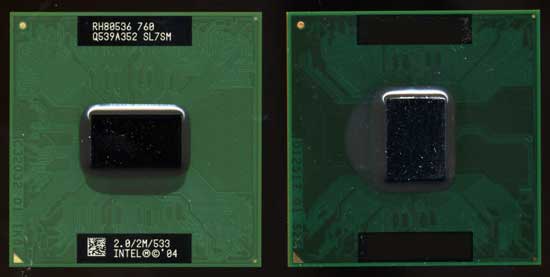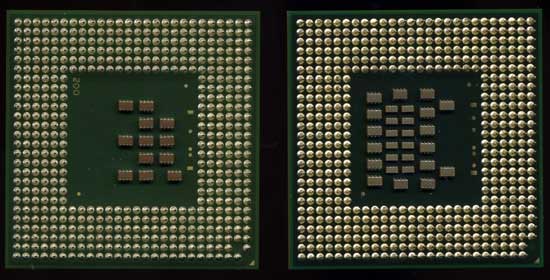Intel Core Duo (Yonah) Performance Preview - Part II
by Anand Lal Shimpi on December 19, 2005 12:55 PM EST- Posted in
- CPUs
It's called the Core Duo
When Yonah first started appearing on roadmaps, we knew it as Jonah, which then starting being written as Yonah. Eventually, Intel confirmed its existence and we had always assumed that it would continue to use the name Pentium M. However, given the great importance of the launch of Intel's first dual-core, low power, notebook processor, it shouldn't be much of a surprise that Intel has a new name in store for it. As you've probably already heard, Yonah will receive the marketing name "Core" with the words "Duo" or "Solo" following it depending on whether it is the dual or single core version. The name Centrino will still be there, but instead of referring to the processor as a Pentium M, it'll be called a Core Duo or a Core Solo. The Centrino platform itself will be referred to as Centrino Duo when paired with a Core Duo processor. We have to admit, we kind of like the new name.
Not so pleasant, however, are the new processor numbers that go along with the new processor names. Gone are Intel's simple three-digit numbers and they have since been replaced with a four-digit number preceded by a letter. The letter indicates the thermal envelope of the processor, while the following four digits denote the performance level of the CPU. If you think that this sounds oddly similar to AMD's Turion processor nomenclature, don't worry; you'd be completely right (of course, the Turion only uses two numbers, while Core Duo uses four). Maybe, one of these days, Intel will get around to copying some more important elements of AMD's history, such as an on-die memory controller or at least a serial bus interface.
As an example of the numbers in use, the 2.0GHz processor that we previewed in the first article will be sold under the name "Intel Core Duo T2500". For your reference, the T2600 will run at 2.16GHz (compared to the 2.0GHz T2500). The Core Solo processors will feature a "1" after the "T" denoting a single core; for example, the Intel Core Solo T1300 will run at 1.66GHz.
Intel's Core Duo and Solo processors both support a 667MHz FSB, which is enabled by the 945 chipset that Intel is pairing with them. The move to a 667MHz FSB is necessary, thanks to the increased bandwidth demands of a dual core processor.
As we mentioned in the first article, the Core Duo (and Solo) processors are not pin-compatible with the older Pentium M, even though they physically have the same number of pins.
When Yonah first started appearing on roadmaps, we knew it as Jonah, which then starting being written as Yonah. Eventually, Intel confirmed its existence and we had always assumed that it would continue to use the name Pentium M. However, given the great importance of the launch of Intel's first dual-core, low power, notebook processor, it shouldn't be much of a surprise that Intel has a new name in store for it. As you've probably already heard, Yonah will receive the marketing name "Core" with the words "Duo" or "Solo" following it depending on whether it is the dual or single core version. The name Centrino will still be there, but instead of referring to the processor as a Pentium M, it'll be called a Core Duo or a Core Solo. The Centrino platform itself will be referred to as Centrino Duo when paired with a Core Duo processor. We have to admit, we kind of like the new name.
Not so pleasant, however, are the new processor numbers that go along with the new processor names. Gone are Intel's simple three-digit numbers and they have since been replaced with a four-digit number preceded by a letter. The letter indicates the thermal envelope of the processor, while the following four digits denote the performance level of the CPU. If you think that this sounds oddly similar to AMD's Turion processor nomenclature, don't worry; you'd be completely right (of course, the Turion only uses two numbers, while Core Duo uses four). Maybe, one of these days, Intel will get around to copying some more important elements of AMD's history, such as an on-die memory controller or at least a serial bus interface.
As an example of the numbers in use, the 2.0GHz processor that we previewed in the first article will be sold under the name "Intel Core Duo T2500". For your reference, the T2600 will run at 2.16GHz (compared to the 2.0GHz T2500). The Core Solo processors will feature a "1" after the "T" denoting a single core; for example, the Intel Core Solo T1300 will run at 1.66GHz.
Intel's Core Duo and Solo processors both support a 667MHz FSB, which is enabled by the 945 chipset that Intel is pairing with them. The move to a 667MHz FSB is necessary, thanks to the increased bandwidth demands of a dual core processor.
As we mentioned in the first article, the Core Duo (and Solo) processors are not pin-compatible with the older Pentium M, even though they physically have the same number of pins.

Dothan (Pentium M) on the left, Yonah (Core Duo) on the Right

Dothan (Pentium M) on the left, Yonah (Core Duo) on the Right










103 Comments
View All Comments
Spoonbender - Monday, December 19, 2005 - link
Am I the only one recalling the old Athlon days?AMD smashes ahead with a great CPU, until around what, 2600+ or so, where they run out of steam, letting Intel overtake them.
Looks like the same might happen again...
Not sure if it's just AMD screwing up, or if it's really a question of resources.
For AMD, Athlon 64 was really a last-ditch gamble. They had to do something big, or they wouldn't exist 5 years from now.
Well, they did, and enjoyed a lot of success, but they might just not have the resources to follow up on it. Instead, their only option might be to milk the A64 for all it's worth, and then take a beating for a year or two, until they're ready with a next-gen architecture
LuxFestinus - Tuesday, December 20, 2005 - link
A question of availability needs to be raised. Are these new duo Intel processors available now? Can anyone say paper launch. How long has the dual Athlon64 been out? I thought so.Griswold - Monday, December 19, 2005 - link
I dont see where you're coming from. The A64 is a K7 on steroids. The P-M is a P3 on steroids and Conroe will also just be a P-M on steroids. Both companies didnt come up with flashy, brandnew architectures over the last few years, they only added flashy things to existing designs. Here and now, it's still Intel playing the catchup game until we see Conroe in stores. And then you always have to keep in mind that AMD is yet to move to 65nm. It will certainly give them some more clockspeed headroom.I agree with the conclusion of the article, we'll see a neck to neck race in a year from now where the better price will make the difference. AMD really doesnt have to flex its muscles now, they can milk the crowd with a superior product - and people will pay whatever to get it, or so it seems.
Calin - Tuesday, December 20, 2005 - link
Several of the flashy brand new architectures of the last few years had any kind of success. Itanium/EPIC, Transmeta, Netburst... As long as Transmeta was supported by a company with very little financial power (so their loss was somewhat expected), Itanium is crawling ahead on life support, and Netburst (while being king of the hill for a good time) will be discontinued.Griswold - Tuesday, December 20, 2005 - link
The point is: Netburst is certainly a design that could be considered newer or more radical compared to the P3->P-M->Yonah/Conroe/Merom route. In the end netburst was still a technical failure, but certainly not a financial mistake.Well and Epic, thats much older than you think. But yes, it never ended up where Intel wanted it to be: on the desktop.
allies - Monday, December 19, 2005 - link
It seems like with Intel's new chips, we're going to be back to a point where neither company has a true lead on the other. AMD is in great position at the moment, but they need to get their Turion X2 out to combat Intel's Centrino Duo. Otherwise, they'll find themselves losing laptop sales, an area which they've come a ways in.Right now, although clockspeed isn't increasing as fast as it once was, is a very exciting time for computer technologies. Parallelism, die shrinking, heat reduction, among other strides are paving the way to the future.
ncage - Monday, December 19, 2005 - link
Are you sure the improvements in games are due to the different Memory Controller technoliges? Are you sure its not the FPU?tfranzese - Monday, December 19, 2005 - link
I was thinking the same, considering his thoughts are pure speculation on his part. So, until Anand can provide data to back that up, he should stick to commending AMD's architecture rather than trying to credit all their success to the on-die memory controller (which surely helps, but it's only one part in the formula).I would doubt AMD is sitting idle though, and as they work on their next architecture will keep their lips sealed in order to maintain an element of surprise. Surprise like when they added SSE support to the Palomino and SSE3 support to Venice - both unexpected additions.
Furen - Monday, December 19, 2005 - link
The K8s execution core is pretty much the same as the K7s. If you compare performance (in games) between the two you'll notice that the K8 performs much better. This is due to the fact that it removes the FSB bottleneck (by integrating the memory controller), increases the width of the L2 cache (and the size) and dramatically drops the memory access latency. Sure there are other minor differences but they're mostly minor improvements, like better branch prediction, etc.tfranzese - Monday, December 19, 2005 - link
I don't see where the two of you are going with this and only serve my point that pinning the successes of the architecture on the memory controller is only speculation.